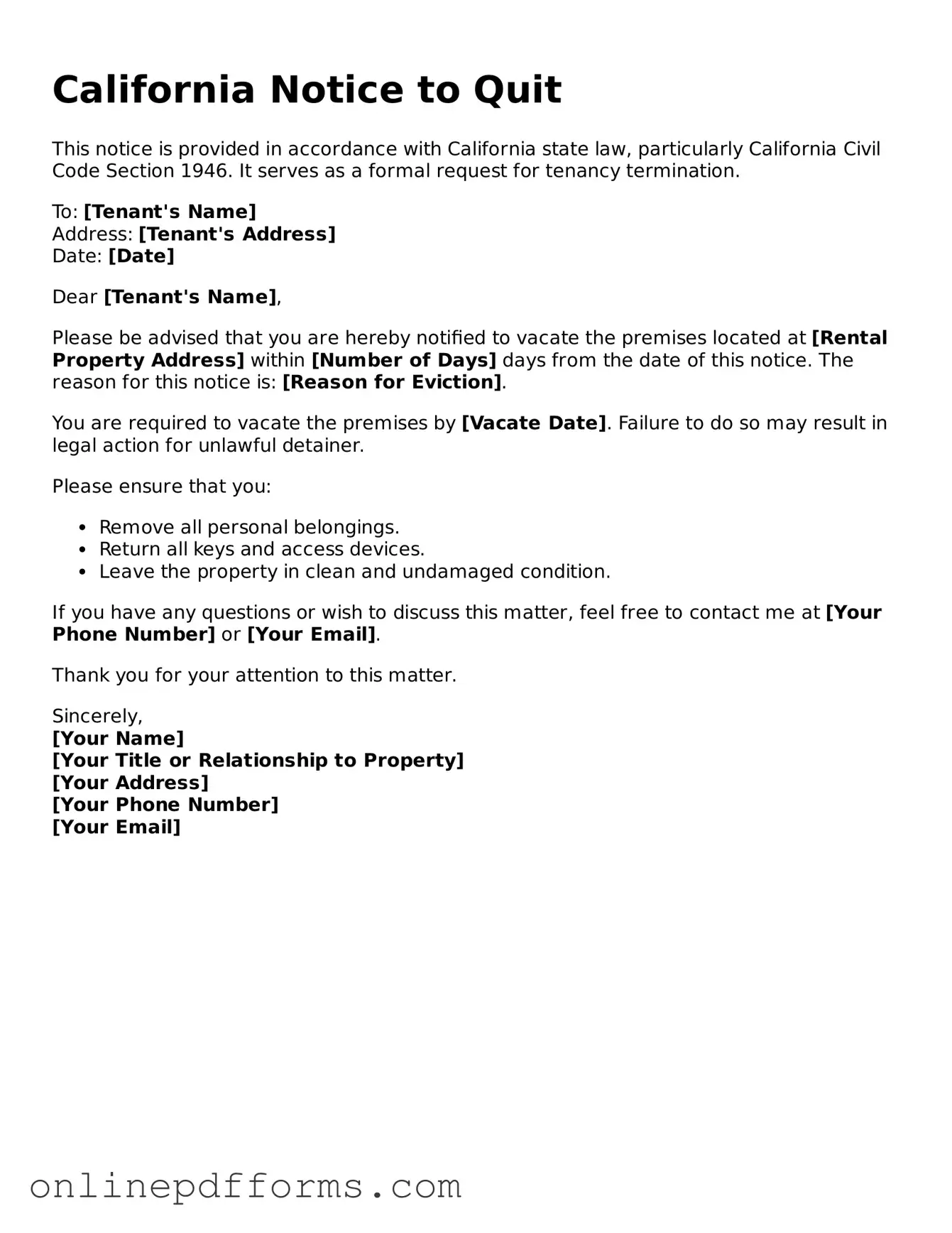The California Notice to Quit form shares similarities with the Eviction Notice, commonly used in various states. Both documents serve as formal notifications to tenants, informing them of the landlord's intent to terminate the lease agreement. The Eviction Notice typically specifies the reason for termination, such as non-payment of rent or lease violations, much like the Notice to Quit, which outlines the tenant's obligation to vacate the premises within a specified timeframe.
Another document akin to the California Notice to Quit is the Pay or Quit Notice. This notice is specifically issued when a tenant has failed to pay rent. It demands payment within a certain period or the tenant must vacate the property. Like the Notice to Quit, it emphasizes the urgency of the situation and outlines the consequences of non-compliance, ultimately leading to potential eviction proceedings.
The Three-Day Notice to Cure or Quit is also similar. This document is used when a tenant has violated a term of their lease. It provides a three-day window for the tenant to correct the violation or face eviction. Both the Three-Day Notice and the Notice to Quit are proactive measures taken by landlords to address issues before escalating to legal action.
The Unlawful Detainer Notice is closely related as well. This document is filed after a tenant has failed to comply with a Notice to Quit or other eviction notice. It initiates the legal process for eviction. While the Notice to Quit serves as a warning, the Unlawful Detainer Notice marks the formal step toward legal proceedings, highlighting the seriousness of the situation.
The Termination of Lease Notice is another document that resembles the Notice to Quit. This notice is often issued at the end of a lease term, indicating that the landlord will not be renewing the lease. Both documents aim to inform tenants of their need to vacate, although the Termination of Lease Notice is typically more straightforward regarding lease expiration rather than lease violations.
A similar document is the Notice of Default. This notice is often used in the context of mortgage agreements but can also apply to rental agreements. It informs tenants that they are in default of their lease terms, such as failing to pay rent. Like the Notice to Quit, it serves as a warning and outlines the next steps that may lead to eviction if the issue is not resolved.
The Lease Termination Agreement can also be compared to the Notice to Quit. While the Notice to Quit is unilateral, informing the tenant of the landlord's intent to end the tenancy, a Lease Termination Agreement is a mutual decision between the landlord and tenant to end the lease. Both documents ultimately lead to the tenant vacating the property, but the Lease Termination Agreement is more collaborative.
The Notice of Non-Renewal is another document that aligns with the Notice to Quit. This notice is issued when a landlord decides not to renew a tenant's lease at the end of the term. Both documents require tenants to vacate the property, but the Notice of Non-Renewal typically does so without the implication of lease violations, focusing instead on the landlord's decision not to continue the rental relationship.
Understanding the importance of proper documentation is crucial when dealing with vehicle transactions. In addition to the standard forms found in real estate, it's essential to be familiar with the Vehicle Bill of Sale Forms, which serve a similar purpose in ensuring that motorcycle sales are legally binding and clear for both parties involved. Having the right paperwork in place can prevent future disputes and protect your interests during the sale process.
Lastly, the Demand for Rent is similar in that it is a formal request for overdue rent. If a tenant fails to respond or pay after receiving this demand, the landlord may then proceed with a Notice to Quit. Both documents highlight the importance of timely payment and the consequences of failing to meet rental obligations.
